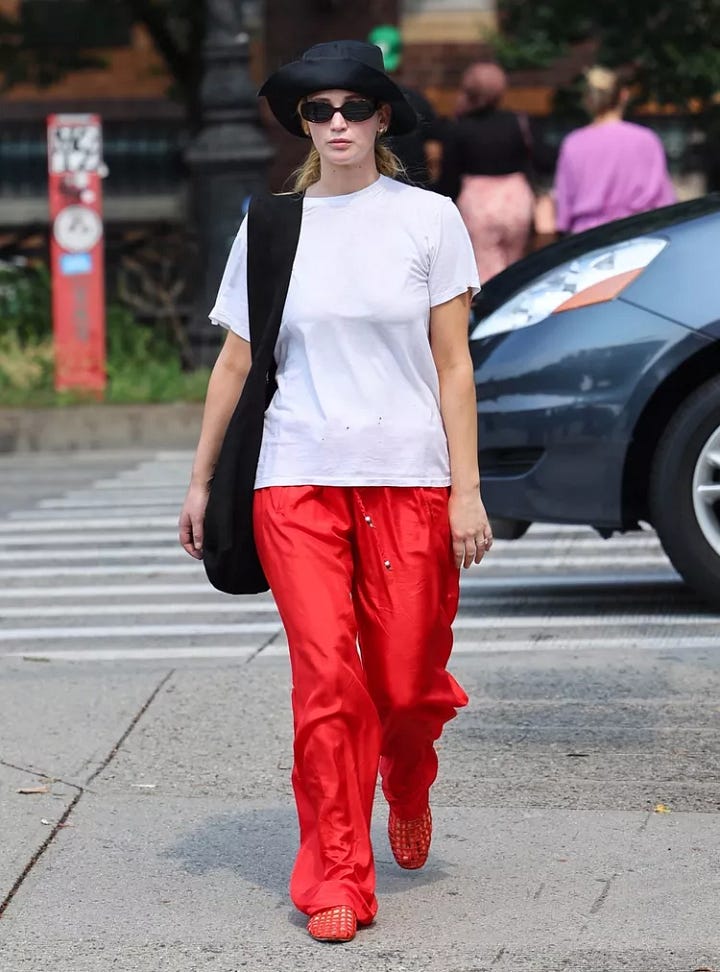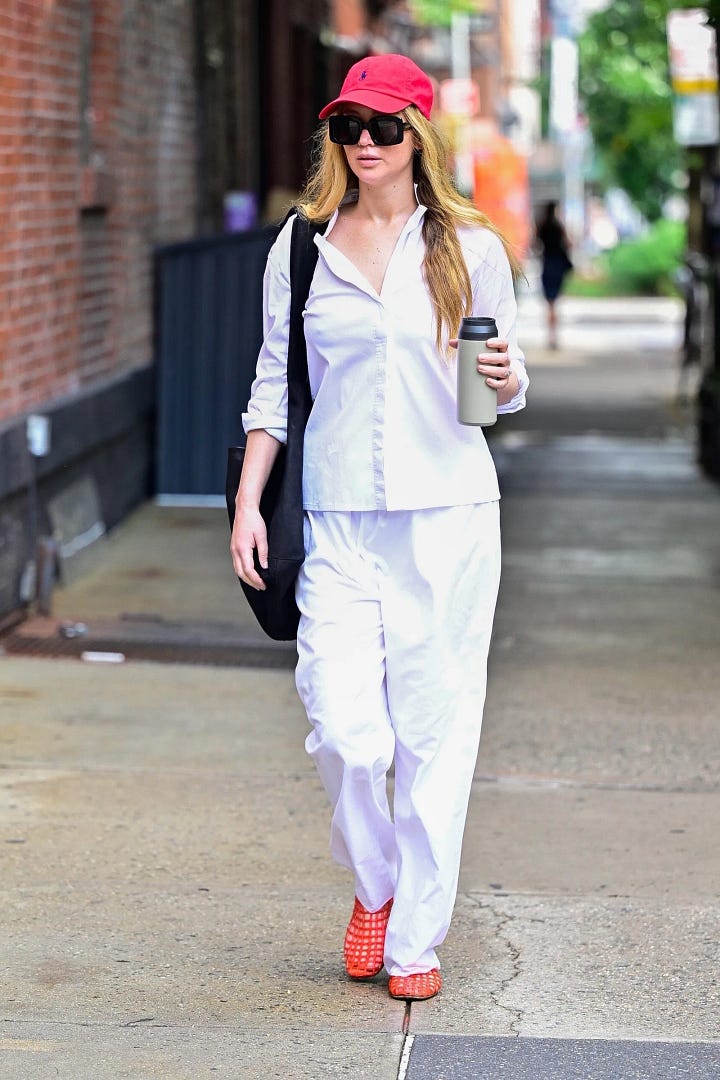Material literacy and the true cost of $900 plastic shoes
On the environmental and health impacts of PVC and how knowledge really is power when it comes to our shopping choices
The freshness of woven jelly flats that flooded my Instagram for the last two months is already dissipating. The style surfaced at the right time, offering an alternative to youthful jelly fisherman sandals for summer and a nuanced evolution from ultra-trendy mesh footwear. The Row’s Pre-Fall 2024 PVC sandal returned the jelly shoe to the zeitgeist and undoubtedly catalyzed the footwear trend. The Row’s woven “Mara” flat ($890) sold out the moment it hit the brand’s website and Jeffrey Campbell’s “Jellz” flat ($50) was sold out and restocked twice. Molly Rooyakkers of Style Analytics found a 100% growth in Google searches for jelly shoes in May, with Pinterest searches up 31% in the US over the last year. The shoe is now decidedly mainstream and the hype around it has likely peaked. This particular microtrend and its significant plastic footprint reveals a lot about our collective material literacy, or our knowledge of where materials originate, how they’re assembled, and their impact throughout their use and life.
In her Slow Factory Open Edu lecture, Seetal Solanki defines materials as the “seemingly mundane fragments and blobs of metal, plastic, ceramic, and glass, [and] other stuff from which our whole civilization is constructed.” How we relate to materials says a lot about our relationship with ourselves and our planet. I strongly believe that the ubiquity of “fossil footwear,” or shoes derived from fossil fuels, shows that our relationship to the materials we wear is fundamentally flawed. Most jelly-style shoes, whether they’re from The Row, Ancient Greek, or MELISSA, are made from PVC (polyvinyl chloride). PVC is a plastic polymer used in footwear, water pipes, and shower curtains. The majority of shoes in our closets and on the market today are composed of plastics and synthetic rubbers. As Alejandra Borunda writes in National Geographic, it’s how we have everything from squishy soles to pointy heels. According to the Ellen MacArthur Foundation, 342 million barrels of petroleum are used by the fashion industry to produce plastic-based fibers such as polyester, nylon, and acrylic.
Consumers in the US, however, are shockingly unaware of the presence of plastic in their clothes and shoes. They are also unaware that plastic is produced from fossil fuels. Based on a public opinion survey of American adults, 7 in 10 Americans are reportedly “not aware the crude oil is used to produce new plastic.” The same survey found that the majority of Americans “are unaware that plastic is in our clothes,” with 27% reporting that they believe “none of their clothes contain the same raw materials used to manufacture plastic.” When videos circulated earlier this month on TikTok and Instagram of The Row jelly flats broken after minimal wear, responses to the video pointed to poor quality and lazy production. Poor material choice is also to blame. The PVC used in The Row’s Mara flat clearly isn’t suitable for daily wear or use, but there’s something more sinister about the material choice to consider. PVC requires additives to make it flexible, durable, lightweight, and water-resistant. These are typically phthalates, which become problematic as EcoCult founder Alden Wicker writes in her book To Dye For:
PVC is a hard plastic unless something is added to make it pliable. That something is most often phthalates, which are endocrine disruptors, and reproductively toxic… Research has connected phthalates with reduced fertility in men, and studies have also linked these chemicals to asthma, cancer, and behavioral problems in children of all genders.
Parents have long been aware of the potential health impacts of phthalates and are rightfully concerned about their children’s exposure to them. In 2017, the Consumer Product Safety Commission banned them from some children’s products but did not impose bans on PVC. Klick Health and Crann Organic recently launched Poisonous Apparel, a campaign to expose toxic substances in children’s clothing and advocate for regulatory reform. They tested children’s clothing and shoes for harmful chemicals present on the AFIRM Restricted Substances List (RSL), including lead, phthalates, formaldehyde, and more. The tests revealed that many of the items sold on popular fast fashion websites contain toxic skin irritants, with some items testing above approved US standards. Jelly shoes, which are a popular children’s shoe style, were found to have lead at 52 ppm and dibutyl phthalate at 26.5 ppm. This is highly concerning, as there is no safe threshold for lead exposure and DBP is a known endocrine disruptor. The jelly shoes failed for organotins as well, which are also linked to endocrine disruption, reproductive and developmental harm, and immune and nervous system damage. Wicker, in her newsletter, advises that women who plan to have kids or experience menstrual and other hormone-related health issues should not purchase and wear jelly shoes of any kind.


If The Row’s Mara, Ancient Greek’s Iro, Jeffrey Campbell’s Jellz, or any of the shoes listed on WhoWhatWear’s buying guide were tested in a similar campaign, what would they reveal? Without transparency into the production process for a 100% PVC shoe and assurance from brands, there’s no guarantee that the woven jelly flats on the feet of celebrities and influencers are carcinogen-free. In Vogue Business’s article from June, “The darker side of jelly shoes,” Rooyakkers analyzed a sample of 380 comments from six TikTok videos discussing the return of jelly shoes. Nostalgia and negative experiences of the shoes (such as bad smells and blisters) were the most common topics she found. Rooyakkers did not find any mentions of ‘PVC’, ‘plastic’, or ‘toxic’ in the comments. The rise and adoption of this trend ultimately reflects a real crisis in consumer awareness and material literacy. Presently, it seems that reading “100% PVC” in the material description for these shoes does not set off alarm bells for many consumers.
Beyond the significant health concerns associated with PVC, there’s the question of the shoe’s environmental impact and end-of-life. Consider that as we wear plastic shoes, whether running errands or trail running, they release microplastics, an estimated 9,000 to 400,000 metric tonnes per year globally from regular use. Rooyakkers also did not find any mentions of words such as ‘sustainability’, ‘recycle’, or ‘environment’ in her analysis of TikTok comments for Vogue Business. Yet the question of recyclability is a massive one. While shoes made from majority PVC like jelly shoes are less complex than other designs with stitching, gluing, and composite materials, curbside recycling programs for the shoes do not exist. Footwear brands do not sponsor product stewardship programs of any kind to collect and recycle PVC shoes once consumers are ready to dispose of them. Thus, without a recycling solution, jelly shoes will be sent to landfill or incinerated. Once in landfills, the shoes will release a range of toxic chemicals: dioxins, carbon monoxide, hydrochloric acid, and polycyclic aromatic hydrocarbons (PAHs). Their disposal is only half of it; their production and combustion is highly polluting and releases dioxins and furans into the surrounding environment.
Theoretically, one could decide to only buy shoes made from wood, twine, and leather. But unless you are staunchly committed to this, it’s hard, if not near-impossible, to buy shoes without plastic. Yet, despite the intractability of plastics in footwear, to see PVC jelly shoes heralded as the it-shoe of the summer feels shockingly backward. There are a number of companies innovating to replace fossil fuel materials with natural alternatives (cork and algae for example). We can make shoes in a way that excises plastic from the design and production process. Yet, the “affordability” of PVC and synthetics, and the willingness of consumers to continue purchasing them, means the PVC footwear market was worth an estimated US $69.2 billion in 2023 and is projected to grow to US $1,06.3 billion by 2030.
Brands opt to use plastics like PVC because they’re cheap and adaptable to trending styles. As Annie Leonard writes in The Story of Stuff, it’s cheaper for brands to use such materials because they do not bear the cost of “making, using, cleaning up after, or disposing of these materials.” The Jellz flat can be sold at $50 per pair because Jeffrey Campbell does not pay for any of the ecological and health impacts associated with the shoe’s production and disposal. What would the PVC flat cost if we factored in the microplastics they will shed during wear, the greenhouse gases (ethylene and methane) they will release once they reach a landfill, the oil fracked to produce them, and the pollution released into communities during their production? Unless told otherwise, I have to assume that The Row does not pay for any of these impacts either, even at $890 per pair.
It feels like we should know better, collectively, than to buy a 100% PVC jelly flat at any price point. Advice to shop more sustainably often revolves around buying less and buying better, better being high quality and natural fibers instead of synthetics. But a materially literate approach to shopping goes beyond this. It’s not necessarily looking at the tag on a garment and deeming it “good” if it’s cotton and “bad” if it’s nylon. Rather, it’s understanding where the material comes from and where it will go after its use, as well as its health and environmental impacts during your use of it. I’m convinced that consumers would be a lot less willing to buy PVC footwear if they were aware of the potential health consequences.
Next summer, jelly shoes will inevitably end up in landfills, where they will sit for centuries. They will be replaced by another it-shoe. To be healthier and more sustainable consumers, it’s in our best interest to make an informed decision before we buy it. It’s in our best interest to be materially literate consumers, to make and act on the connection between what we wear, our health, and the planet’s health, lest we spend $50 or $900 on toxic plastic shoes.






Great work! It's also interesting to think of these luxury good companies using very cheap materials, like plastics, in their extremely expensive products. Plastic is looked down upon when being sold at Walmart, but if you buy it from the Row, suddenly it's chic.....and even though I know why that marketing magic trick works, I'm surprised it still fools people.
I hit the heart button even before I read.
Can we add Crocs to this too?